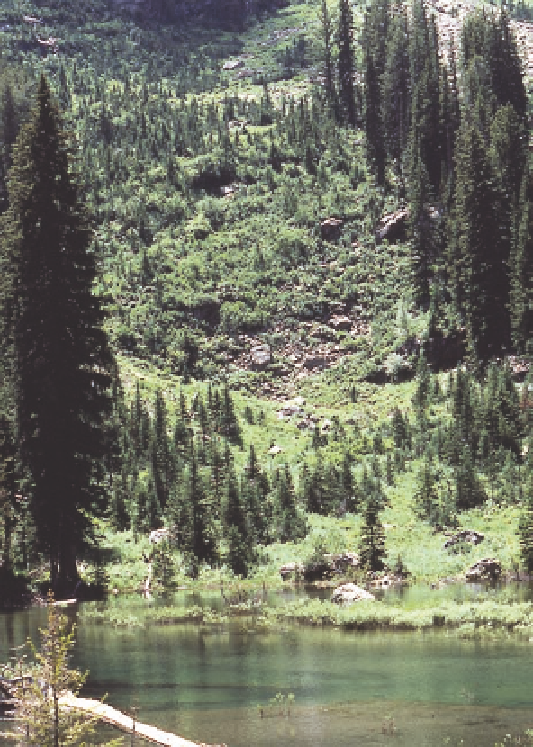Geoscience Reference
In-Depth Information
though wind surely contributes to treeline forma-
tion through its effect on snow accumulation and new
seedling establishment, there is compelling evidence
trees have woody stems and branches that must be
maintained by carbon-rich compounds produced by
photosynthesis—a temperature-dependent process. As
elevation increases, temperatures become too low for too
much of the growing season to allow the amount of pho-
tosynthesis required for the year-round maintenance of
large plants. Hence, the trees become shorter and even
shrubby in nature, and at some point, small seedlings
cannot survive either. Worldwide, trees are absent where
the growing season is shorter than 3 months and the
growing season average temperature is less than about
are clearly better adapted for the cold alpine environ-
ment, probably because less photosynthesis is required
to maintain small plants and the roots and rhizomes of
such plants store carbohydrates for the production of
new leaves early the following year. Small plants also are
more likely to be protected by snow cover during winter.
Predictably, some trees have adaptations that
enable them to tolerate the cold treeline environment.
For example, treeline conifers have clustered needle-
leaf arrangements that tend to maintain daytime leaf
temperatures that are considerably warmer than the
photosynthesis in the cool alpine environment and
occurs because leaf clusters (1) present a more dense
mass for the absorption of solar radiation and (2) mini-
mize wind movement through the needles, thereby
reducing cooling. Limber pine and whitebark pine are
adapted in another way, namely, flexible branches that
reduce breakage from strong winds.
12
the challenge of understanding treelines is illus-
trated by the hypothesis that trees cannot survive in
alpine environments because the summer is too short,
cool, and dry to allow development of the protective
tissues required to tolerate abrasion the following win-
ter. Although plausible, Julian Hadley and William K.
Smith concluded that this hypothesis does not apply
that wind-caused abrasion during the winter was more
important than a short growing season. Still other fac-
tors affecting treeline elevation are more intense ultra-
violet radiation and the excessive reflection of solar
radiation from snow onto leaves—both of which can
retard physiological processes.
Avalanches
Snow avalanche tracks are a conspicuous feature of
treelines where large volumes of drifting snow accumu-
late, such as on the lee side of high ridges and where
snow slides are common (fig. 14.4). Such areas are par-
ticularly common in colorado, northwestern Wyo-
ming, and parts of the northern Rocky Mountains.
Usually the snow accumulates in the alpine zone and
Fig. 14.4. Avalanche track in cascade canyon, Grand teton
national Park. tree damage is less frequent at the lower end
of the track, enabling the trees to grow taller there. However,
as the trees grow larger, they offer more resistance to the ava-
lanche and are more likely to break or be uprooted. the trees
are subalpine fir and engelmann spruce. the more flexible
shrubs higher on the slope include bearberry honeysuckle,
mountain ash, Rocky Mountain maple, rusty menziesia, and
serviceberry. elevation at the bottom is 7,216 feet.

Search WWH ::

Custom Search